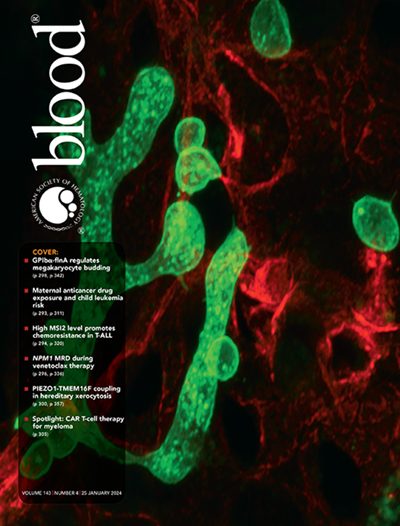Disease risk but not remission status determines transplant outcomes in AML: long-term outcomes of the ASAP trial.
IF 23.1
1区 医学
Q1 HEMATOLOGY
引用次数: 0
Abstract
Attempting to induce a complete remission (CR) prior to allogeneic hematopoietic cell transplantation (alloHCT) is current practice in patients with AML. A benefit of remission induction prior to alloHCT, however, has never been proven in a prospective trial. Potent conditioning regimens exist which allow for successful alloHCT in patients with active AML. Therefore, the ASAP trial was conducted to test remission induction by salvage chemotherapy prior to alloHCT against immediate transplantation after intensified conditioning. In total 281 patients with AML with poor response after first induction or untreated first relapse were randomized 1:1 to remission induction (RIST) with high-dose cytarabine plus mitoxantrone versus immediate alloHCT with sequential conditioning after non-intensive disease control measures (DisC) preferentially watchful waiting only. Overall survival (OS) at 5 years from randomization analyzed according to ITT was 46.1% for DisC versus 47.5% for RIST (p=0.82). In multivariable Cox regression analysis, genetic AML risk according to ELN (p<0.0001), age (p=0.001) and comorbidities (p=0.046) predicted survival, but not treatment arm (HR 1.08 for DisC versus RIST, p=0.67). In conclusion, long-term follow-up of the ASAP trial showed no survival advantage for standard salvage chemotherapy prior to alloHCT as opposed to immediate alloHCT. The trial results question the general concept of remission induction with intensive standard salvage therapy prior to alloHCT for all patients, since immediate alloHCT may reduce time in hospital and health care expenses. Well tolerable novel bridging therapies and post-transplant maintenance with targeted drugs are urgently warranted, especially for adverse-risk AML, to improve outcome after alloHCT. NCT02461537.疾病风险而非缓解状态决定AML移植结果:ASAP试验的长期结果。
在同种异体造血细胞移植(alloHCT)之前试图诱导完全缓解(CR)是目前AML患者的做法。然而,在同种异体造血干细胞移植之前,缓解诱导的益处从未在前瞻性试验中得到证实。存在有效的调节方案,允许在活动性AML患者中成功进行同种异体hct。因此,ASAP试验是为了测试同种异体造血干细胞移植前补救性化疗对强化调理后立即移植的缓解诱导作用。共有281例首次诱导反应不良或未治疗首次复发的AML患者被1:1随机分为高剂量阿糖胞苷加米托蒽醌的缓解诱导(RIST)组和非强化疾病控制措施(DisC)优先观察等待后的顺序调理的立即异源肝移植(alloHCT)组。根据ITT分析随机化后的5年总生存率(OS), DisC组为46.1%,而RIST组为47.5% (p=0.82)。在多变量Cox回归分析中,根据ELN (p<0.0001)、年龄(p=0.001)和合并症(p=0.046)的遗传AML风险预测生存,但与治疗组无关(DisC与RIST的HR为1.08,p=0.67)。总之,ASAP试验的长期随访显示,与立即进行同种异体移植相比,在同种异体移植前进行标准补救性化疗没有生存优势。试验结果质疑了在所有患者进行同种异体移植前采用强化标准挽救性治疗诱导缓解的一般概念,因为立即进行同种异体移植可以减少住院时间和医疗费用。迫切需要耐受良好的新型桥接疗法和移植后靶向药物的维持,特别是对于不良风险AML,以改善同种异体hct后的预后。NCT02461537。
本文章由计算机程序翻译,如有差异,请以英文原文为准。
求助全文
约1分钟内获得全文
求助全文
来源期刊

Blood
医学-血液学
CiteScore
23.60
自引率
3.90%
发文量
955
审稿时长
1 months
期刊介绍:
Blood, the official journal of the American Society of Hematology, published online and in print, provides an international forum for the publication of original articles describing basic laboratory, translational, and clinical investigations in hematology. Primary research articles will be published under the following scientific categories: Clinical Trials and Observations; Gene Therapy; Hematopoiesis and Stem Cells; Immunobiology and Immunotherapy scope; Myeloid Neoplasia; Lymphoid Neoplasia; Phagocytes, Granulocytes and Myelopoiesis; Platelets and Thrombopoiesis; Red Cells, Iron and Erythropoiesis; Thrombosis and Hemostasis; Transfusion Medicine; Transplantation; and Vascular Biology. Papers can be listed under more than one category as appropriate.
 求助内容:
求助内容: 应助结果提醒方式:
应助结果提醒方式:


